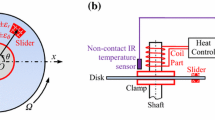Abstract
A number of studies has shown that natural frequencies and, accordingly, the minimum critical speed for the formation of a standing wave in thin, rotating, circular disks can be beneficially altered by purposely induced initial membrane stresses. The possibility of controlling natural frequencies by induced thermal membrane stresses, rather than initial stresses, has received some previous theoretical attention and is experimentally examined here for a stationary, constant-thickness, centrally clamped, circular disk. The primary advantages of thermal membrane stresses are manifested in the inherent flexibility in adjustment of the thermal as opposed to the initial stresses.
Increases in the minimum critical speed, which is proportional here to the zero nodal circle—two nodal-diameter natural frequency, of 20 percent were determined with moderate heating. This can be considered a relatively small critical-speed increase when compared with variations expected in many common rotating disk environments.
A thermal model, which utilizes as input the peripheral disk heat flux and the controlled disk temperature at some known radius, is shown to predict the temperature distribution and natural frequencies with reasonable accuracy. The applicability of this model enhances the potential practicality of the induced thermal-membrane-stress method of natural frequency and/or critical speed control.
Similar content being viewed by others
Abbreviations
- a :
-
nondimensional clamping radius,a/b
- b :
-
peripheral radius
- c :
-
nondimensional external heating radius,c/b
- D :
-
flexural stiffness
- E ′ :
-
modified elastic modulus,\({E \mathord{\left/ {\vphantom {E {3(1 - v^2 )}}} \right. \kern-\nulldelimiterspace} {3(1 - v^2 )}}\)
- f :
-
radial-displacement distribution
- H :
-
1/2 disk thickness
- h 1D :
-
modified Biot number for disk,hb 2 /k D H
- I o :
-
zero-order Bessel function of the first kind with imaginary argument
- K o :
-
zero-order Bessel function of the second kind with imaginary argument
- n :
-
number of nodal diameters
- r:
-
nondimensional radius,r/b
- u:
-
nondimensional radial displacement,\(\frac{u}{{b (1 + v) \alpha \theta _o }}\)
- w :
-
transverse displacement
- α:
-
linear thermal-expansion coefficient
- Δ:
-
radial-coordinate increment
- θ:
-
disk temperature relative to surrounding air
- θ:
-
nondimensional relative temperature,\({\theta \mathord{\left/ {\vphantom {\theta {\theta _o }}} \right. \kern-\nulldelimiterspace} {\theta _o }}\)
- θ o :
-
ambient reference temperature
- κ:
-
1−ν/1+ν
- л:
-
nondimensional natural frequency squared,\(\omega _n ^2 \) ϱb 4 /E ′ H 2
- μ:
-
nondimensional parameters,\(3 (1 - v^2 ) \alpha \theta _0 \frac{{b^2 }}{{H^2 }}\)
- ν:
-
Poisson's ratio
- ϱ:
-
disk density
- \(\sigma _{rr} \) :
-
nondimensional radial membrane stress,\(\frac{{\sigma rr}}{{\alpha E\theta _o }}\)
- \(\sigma _{\phi \phi } \) :
-
nondimensional hoop membrane stress,\(\frac{{\sigma \phi \phi }}{{\alpha E\theta _o }}\)
- ϕ:
-
integral defined in eq (11)
- ψ:
-
nondimensional parameter,\(\omega _o ^2 \frac{{\rho b^4 }}{{E'H^2 }}\)
- \(\Omega _o \) :
-
nondimensional disk angular velocity,\(\omega _o \sqrt {\frac{{\rho b^2 }}{{8\alpha E\theta _o }}} \)
- \(\omega _n \) :
-
zero-nodal circle-n diam natural frequency
- \(\omega _c \) :
-
critical speed—speed at which a standing wave is formed in a disk rotating past a stationary axial force
References
Dugdale, D. S., “Stiffness of a Spinning Disc Clamped at its Centre,”Jnl. Mech. Phys. Solids,14,349–456 (1966).
Dugdale, D. S., “Theory of Circular Saw Tensioning,”Internatl. Jnl. Prod. Res.,4,237–248 (1966).
Dugdale, D. S., “Effect of Internal Stress on the Flexural Stiffness of Discs,”Internatl. Jnl. Engr. Sci.,1,89–100 (1963).
Dugdale, D. S., “Effect of Internal Stress on Elastic Stiffness,”Jnl. Mech. Phys. Solids,11,41–47 (1963).
Mote, C. D., Jr., “Natural Frequencies in Annuli with Induced Thermal Membrane Stresses,”Trans. ASME,89 (B),611–618 (1967).
Mote, C. D., Jr., “Theory of Thermal Natural Frequency Variations in Disks,”Internatl. Jnl. Mech. Sci.,8,547–557 (1966).
Mote, C. D., Jr., “Free Vibration of Initially Stressed Circular Disks,”Trans. ASME,87 (B),258–264 (1965).
Prescott, John, “Applied Elasticity,”Dover Publications, Inc., New York, N. Y., 572–618 (1961).
Vogel, S. M. andSkinner, D. W., “Natural Frequencies of Transversely Vibrating Uniform Annular Plates,”Jnl. Appl. Mech.,32,926–931 (1965).
Author information
Authors and Affiliations
Rights and permissions
About this article
Cite this article
Mote, C.D., Rakowski, J.E. Thermally induced natural-frequency variations in a thin disk. Experimental Mechanics 9, 1–8 (1969). https://doi.org/10.1007/BF02327871
Issue Date:
DOI: https://doi.org/10.1007/BF02327871




